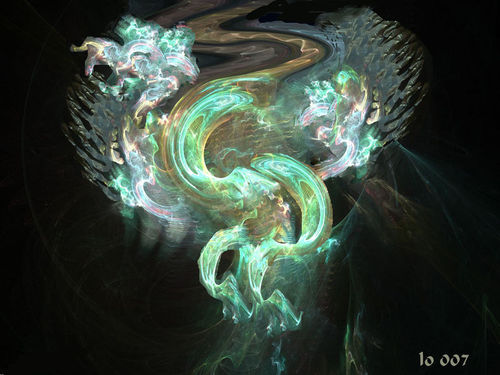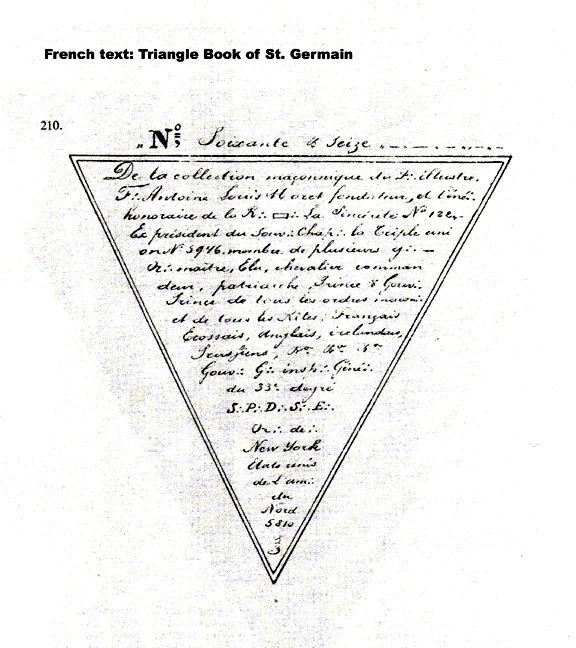Provenance
PROVENANCE
Provenance
This manuscript passed from the collection of Moret to the famous library of occult books and manuscripts formed by the late Mme. Barbe of Paris. In the interval it had belonged to Stanislaus de Guaita, French transcendentalist, who purchased it at the sale of books belonging to Jules Favre, the French Statesman and bibliophile. Moret was one of the heads of Masonry in Europe and America. He came to America and settled here for some time. The manuscript, therefore, is of greatest importance in the literature of early American Masonry.
During the middle years of the 19th century, a school of transcendentalists came into being in France under the able leadersip of Abbe Louis Constant, better known by is pseudonym Eliphas Levi. He was a member of the Fratres Lucis, and was devoted to the mysteries of the Holy Cabala. Levi gethered around himself a brilliant group of European intellectuals who devoted much time to searching out available information on St.-Germain. Most of the rarer books and manuscripts passed through their hands, and in some cases copies were made. These are almost as scarce as the orignals.
PROVENANCE: It is not known for sure if St. Germain actually wrote these rites or adapted them from an older magical text in his possession. This manuscript was offered at the Hauser Sale in 1933 (item #527). The key to the cypher in an accompanying bound volume was provided with the lot. A typed French transcription and English translation are to be found in the bound volume, inserted in the slip-case. Another French translation is in the bound volume accompanying the other copy of this text, provided by the bookseller.
MS 209 was bought from Frank Hollings, a London antiquary, after 1933. It came from the occult library of Mme. Barbe, who had gotten it from the bibliographer Stanislaus de Guaita, who bought it from an auction of the library of Jules Favre. It is a copy made from one of the magical texts in the possession of St. Germain by the owner's permission. A number of such copies were executed for the members of his Masonic lodge in Paris, and the following manuscript (210), as different in style as it is, may be one of the copies too. It is unclear in both cases whether the Comte St. Germain wrote these magical formulae or owned a copy of an ancient text. This manuscript was made for Antoine Louis Moret, a French emigre to America active in Masonry and politics.
The litany of St. Germain's miracles--his eternal youthfulness, his incomparable painting of pigments made from the colors magically pulled out of gemstones, his endless wealth, his invisibility, his brilliant sonatas, and inspired violin performances, the flaws removed from the King's diamonds, metals transmuted, languages spoken, friends among the long-dead -- these and many more tales, and a few unflattering references in the shards of eighteenth century diplomacy constitute his whole legend. He is said to have whispered words of unheeded advice to Marie Antoinette. His image remains the centerpiece of newly fabricated mythologies, often of Rosicrucian, Masonic and New Age origin. There remain a number of remarkable contemporary testimonies and unsolved puzzles. As for hard evidence, there is none.
St. Germain has been described as the greatest of European adepts. His prodigious knowledge of history and philosophy was often commented on in his day. In a letter to Frederick II, Voltaire described St. Germain as "the man who never dies."
Both MS 209 and 210 now reside in the Getty Research library, having been sold in the estate auction of Manly Palmer Hall by his lawyers to satisfy debts.
MS 209 has 31 leaves, 4 are blank. 21.0 x 24.4 x 24.4 (triangular)
MS 210 has 24 triangular leaves, 23.7 x 23.7 x 23.5
Mid 18th c. French, blue and gold ink on ruled parchment. Text in cipher with two magical illustrations in gilt and several other colors of ink. MS 209 has 3 illustrations in gilt and other colors of ink. French portions of text in both are in script.
[ Box 35 ]
Ex Dono Sapientissimi Comitis St. Germain Qoi Orbem Terrarum Per Cucurrit. [ ca. 1750 ]
Comte St. Germain. 28.4 x 22 cm. 24 leaves. Illustrations, ink, gilt. Contains translation of Masonic symbols. Triangular book. [210]
Hall (Manly Palmer) Collection of Alchemical Manuscripts, 1500-1825
Finding aid prepared by Trevor Bond.The Getty Research Library
Special Collections and Visual Resources
1200 Getty Center Drive, Suite 1100
Los Angeles, California 90049-1688
Phone: (310) 440-7390
Fax: (310) 440-7780
Email: reference@getty.edu
URL: http://www.getty.edu/research/library
©1998
J. Paul Getty Trust.
Descriptive Summary
Title:
Manly Palmer Hall Collection of Alchemical Manuscripts, 1500-1825
Collection number:
Accession no. 950053
Collector:
Hall, Manly Palmer, 1901-
Extent:
7.5 linear ft.
Abstract:
A collection of 243 manuscripts detailing the arts of Alchemy, Hermeticism, Rosicrucianism, and Masonry, gathered over a lifetime by Many Palmer Hall, author and researcher in the realms of mysticism and the occult and related areas.
Trevor Bond processed the collection January 1998 and wrote the finding aid March 1998
224 printed books were transferred to the library on June 6, 1995.
What's New with My Subject?
| Saint-Germain: The Immortal Count | |
|
Is it possible that a man can achieve immortality - to live forever? That is the startling claim of a historical figure known as Count de Saint-Germain. Records date his birth to the late 1600s, although some believe that his longevity reaches back to the time of Christ. He has appeared many times throughout history - even as recently as the 1970s - always appearing to be about 45 years old. He was known by many of the most famous figures of European history, including Casanova, Madame de Pampadour, Voltaire, King Louis XV, Catherine the Great, Anton Mesmer and others.
Who was this mysterious man? Are the stories of his immortality mere legend and folklore? Or is it possible that he really did discover the secret of defeating death?
Origins
When the man who first became known as Saint-Germain was born is unknown, although most accounts say he was born in the 1690s. A genealogy compiled by Annie Besant for her co-authored book, The Comte De St. Germain: The Secret of Kings, asserts that he was born the son of Francis Racoczi II, Prince of Transylvania in 1690. Other accounts, taken less seriously by most, say he was alive in the time of Jesus and attended the wedding at Cana, where the young Jesus turned water into wine. He was also said to be present at the council of Nicaea in 325 A.D.
What is almost unanimously agreed on, however, is that Saint-Germain became accomplished in the art of alchemy, the mystical "science" that strives to control the elements. The foremost goal of this practice was the creation of "projection powder" or the elusive "philosopher's stone," which, it was claimed, when added to the molten form of such base metals as lead could turn them into pure silver or gold. Furthermore, this magical power could be used in an elixir that would impart immortality on those who drank it. Count de Saint-Germain, it is believed, discovered this secret of alchemy.
Courting European Society
Saint-Germain first came into prominence in the high society of Europe in 1742. He had just spent five years in the shah of Persia's court where he had learned the jeweler's craft. He beguiled the royals and the rich with his vast knowledge of science and history, his musical ability, his easy charm and quick wit. He spoke many languages fluently, including French, German, Dutch, Spanish, Portuguese, Russian and English, and was further familiar with Chinese, Latin, Arabic - even ancient Greek and Sanskrit.
It might have been his extraordinary learnedness that led acquaintances to see that he was a remarkable man, but an anecdote from 1760 most likely gave rise to the notion that Saint-Germain could be immortal. In Paris that year, Countess von Georgy heard that a Count de Saint-Germain had arrived for a soiree at the home of Madame de Pompadour, mistress of King Louis XV of France. The elderly countess was curious because she had known a Count de Saint-Germain while in Venice in 1710. Upon meeting the count again, she was astonished to see that he hadn't appeared to age, and asked him if it was his father she knew in Venice.
"No, Madame," he replied, "but I myself was living in Venice at the end of the last and the beginning of this century; I had the honor to pay you court then."
"Forgive me, but that it impossible!" the perplexed countess said. "The Count de Saint-Germain I knew in those days was at least forty-five years old. And you, at the outside, are that age at present."
"Madame, I am very old," he said with a knowing smile.
"But then you must be nearly 100 years old," said the astonished countess.
"That is not impossible," the count told her matter-of-factly, then continued to convince the countess that he was indeed the same man she knew with the details of their previous meetings and of life in Venice 50 years earlier.
Ever Present, Never Aging
Saint-Germain traveled extensively throughout Europe over the next 40 years - and in all that time never seemed to age. Those who met him were impressed by his many abilities and peculiarities:
- He could play the violin like a virtuoso.
- He was an accomplished painter.
- Wherever he traveled, he set up an elaborate laboratory, presumably for his alchemy work.
- He seemed to be a man of great wealth, but was not known to have any bank accounts. (If it was due to his ability to transmute base metals into gold, he never performed the feat for observers.)
- He dined often with friends because he enjoyed their company, but was rarely seen to eat food in public. He subsisted, it was said, on a diet of oatmeal.
- He prescribed recipes for the removal of facial wrinkles and for dyeing hair.
- He loved jewels, and much of his clothing - including his shoes - were studded with them.
- He had perfected a technique for painting jewels.
- He claimed to be able to fuse several small diamonds into one large one. He also said he could make pearls grow to incredible sizes.
- He has been linked to several secret societies, including the Rosicrucians, Freemasons, Society of Asiatic Brothers, the Knights of Light, the Illuminati and Order of the Templars.
The renowned 18th philosopher, Voltaire - himself a respected man of science and reason - said of Saint-Germain that he is "a man who never dies, and who knows everything."

